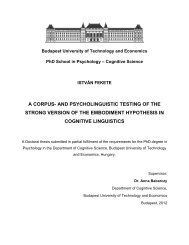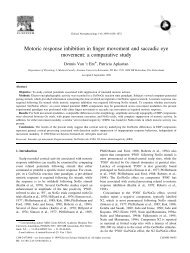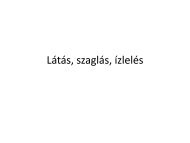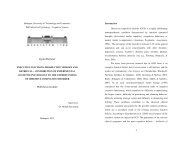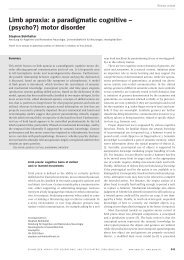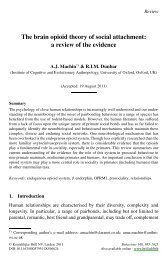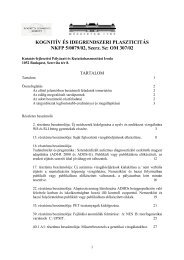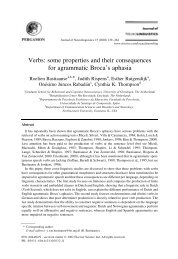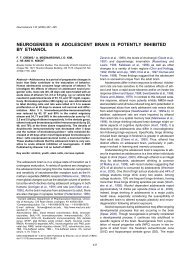Gyula Demeter
Gyula Demeter
Gyula Demeter
You also want an ePaper? Increase the reach of your titles
YUMPU automatically turns print PDFs into web optimized ePapers that Google loves.
Shifting<br />
The shifting component of the executive system is responsible for coordinating the<br />
change between relevant and irrelevant sets. The task that is most often used to study the set-<br />
shifting abilities of OCD patients is the Wisconsin Card Sorting Task (WCST, Berg, 1948;<br />
Heaton, 1981). WCST is a complex task and depending on the structural equation modeling<br />
analyses used it mainly reflects the shifting component of the executive system (Miyake et al.,<br />
2000).<br />
In the standard computer version of the task, four stimulus cards with symbols differing<br />
in colour, shape, and number appear on the top of the screen and the subjects had to match a<br />
target card which appeared on the middle of the screen with one of the four stimulus cards.<br />
After each placement, the subject is informed via a message on the screen whether the<br />
response is correct or incorrect. Participants are instructed to sort the target cards into piles<br />
under the reference cards according to one sorting principle. The subject has to get as many<br />
cards right as possible. After 10 consecutive correct matches with the first criterion (colour)<br />
the sorting principle is changed without warning to a second one (form), then to a third one<br />
(number) and the subject has to find the correct sorting strategy using the received feed-backs<br />
on the screen. The subject must be able to reject the old rule and to switch to the discovered<br />
new one. The procedure is repeated twice or until all of the 128 matching cards were used.<br />
The indices considered for the test evaluation are as follows: Trails administered, Total<br />
correct, Perseverative responses, Perseverative errors, Nonperseverative errors, Conceptual<br />
level responses, Categories completed, Trails to complete first category, Failure to maintain<br />
set and Learning to learn.<br />
Some studies have described set-shifting deficits in OCD using the WCST (Boone,<br />
Ananth, & Philipott, 1991; Hymas et al., 1991; Okasha et al., 2000; Roh et al., 2005;<br />
Mukhopadhyay et al., 2010), but others have not (Zielinski et al., 1991; Abbruzzese, Ferri, &<br />
Scarone, 1995a, 1995b, 1997; Moritz, Fricke, Wagner, & Hand, 2001). Roh et al. (2005) in a<br />
more recent study have found that OCD patients commit more perseverative responses and<br />
errors on this task. Because this task was one of our main assessment tool for the shifting<br />
component of the executive system in our research (Study 1) we present at the end of this<br />
section a detailed overview of the studies using WCST from the literature (see Table 1 for<br />
details).<br />
The results obtained on the Object Alternation Task (OAT, Freedman, 1990), Delayed<br />
Alternation Task (DAT, Freedman and Oscar-Berman, 1986) (Abbruzzese et al., 1995a;<br />
Gross-Isseroff et al., 1996; Abbruzzese et al., 1997; Moritz et al., 2001; Spitznagel and Suhr,<br />
16



